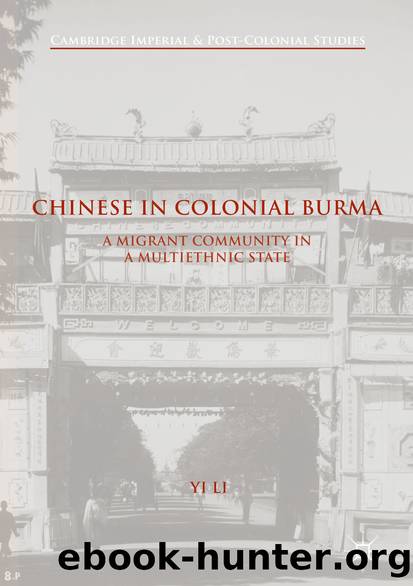Chinese in Colonial Burma by Yi Li

Author:Yi Li
Language: eng
Format: epub
Publisher: Palgrave Macmillan US, New York
4.2 The âShort-sleevesâ Chinese
The English publications, the opinion-makers of the general English public in the colonial era, as well as the Chinese elders today in Yangon have no hesitation to present and emphasize an image of the Chinese as a real âcommercial race.â However, it is not difficult to dig out the other side of the story. In fact, it is too obvious to ignore because that comes from the popular nicknames for the Chinese in the Burmese language. The Chinese, as known by the ordinary Burmese, were commonly categorized into two groups, the leq-she (long-sleeves) and the leq-to (short-sleeves). These terms came from the typical outfit of the Burmese Chinese, the former referred to the merchants, shop assistants, and other clerks who had to wear jackets with long sleeves, mostly Hokkien, while the latter referred to the simpler clothes convenient for outdoor workers, such as carpenters and builders, often Cantonese. 75 In fact, these two words became the defining feature of the two Chinese groups, so much so that in the 1930s, one Cantonese boy in the delta was asked by his primary school teacher to compare his arms (leq also means arms) with those of his Indian, Karen, and Burmese classmates. To everyoneâs disappointment, they found that this Chinese boyâs arms were not particularly longer or shorter than theirs. 76
If an ordinary Burmese schoolboy knew the difference between âlong-sleevesâ and âshort-sleevesâ Chinese, obviously there were a large number of Chinese laborers in the colony, as many perhaps as that of merchants. This should have been common knowledge in the colony, contradicting the popular image of Chinese as merchants. Contemporary census data indeed verified this distribution of labor, with the percentage of Chinese âtraders and merchantsâ (41 percent) plus âclerical workersâ (5 percent) almost equal to that of Chinese âcarpenters and workersâ (38 percent) and âsemi-skilled workersâ (9 percent) combined in Burma in 1931. 77
Other sources support a diversified job profile with more details. In the Chinese community of Tavoy, it was believed that the earliest local association, the Xiangshan Association, was organized by the Cantonese from Xiangshan (Zhongshan) County who worked in nearby mines. 78 Maingy, the first Commissioner of Tenasserim in 1825, remembered how Low Ah Chong, probably a Cantonese, claimed âhe would form a labour gang out of one thousand Melakan Chinese to work tin-mines in Tavoy.â 79 This practice was resumed after the British completed the final annexation in 1886. In 1888, a surveyor from Calcutta and a revenue officer from Rangoon were sent to Perak in Malaya to study the local tin mines worked by Chinese labor âwith a view to the adoption of similar labour in the development of tin resources in Tenasserim.â 80
To prepare for the Second Anglo-Burmese War in 1852, British forces arranged in advance to make sure that âtimber, mats, etc. for the construction of temporary barracks were prepared by Chinese carpenters at Moulmein to be taken to Rangoon in due course.â 81 The father of U Shwe I, a
Download
This site does not store any files on its server. We only index and link to content provided by other sites. Please contact the content providers to delete copyright contents if any and email us, we'll remove relevant links or contents immediately.
| Africa | Americas |
| Arctic & Antarctica | Asia |
| Australia & Oceania | Europe |
| Middle East | Russia |
| United States | World |
| Ancient Civilizations | Military |
| Historical Study & Educational Resources |
The Story of China by Michael Wood(927)
Mr. Selden's Map of China by Timothy Brook(774)
Philippines--Culture Smart! by Culture Smart!(669)
Heroic Hindu Resistance To Muslim Invaders (636 AD to 1206 AD) by Sita Ram Goel(654)
Akbar: The Great Mughal by Ira Mukhoty(650)
The Meaning of India by Raja Rao(631)
Vedic Physics: Scientific Origin of Hinduism by Raja Ram Mohan Roy(624)
Food of India by unknow(615)
Banaras by Diana L. Eck(613)
India--Culture Smart! by Becky Stephen(602)
China Unbound by Joanna Chiu(601)
First Platoon by Annie Jacobsen(598)
Mao's Great Famine: The History of China's Most Devastating Catastrophe, 1958-1962 by Frank Dikötter(594)
North of South by Shiva Naipaul(588)
Insurgency and Counterinsurgency by Jeremy Black(564)
How to Be a Modern Samurai by Antony Cummins(561)
A History of Japan by R.H.P. Mason & J.G. Caiger(561)
The Genius of China: 3,000 Years of Science, Discovery, and Invention by Robert Temple(560)
The Digital Silk Road by Jonathan E. Hillman(549)
